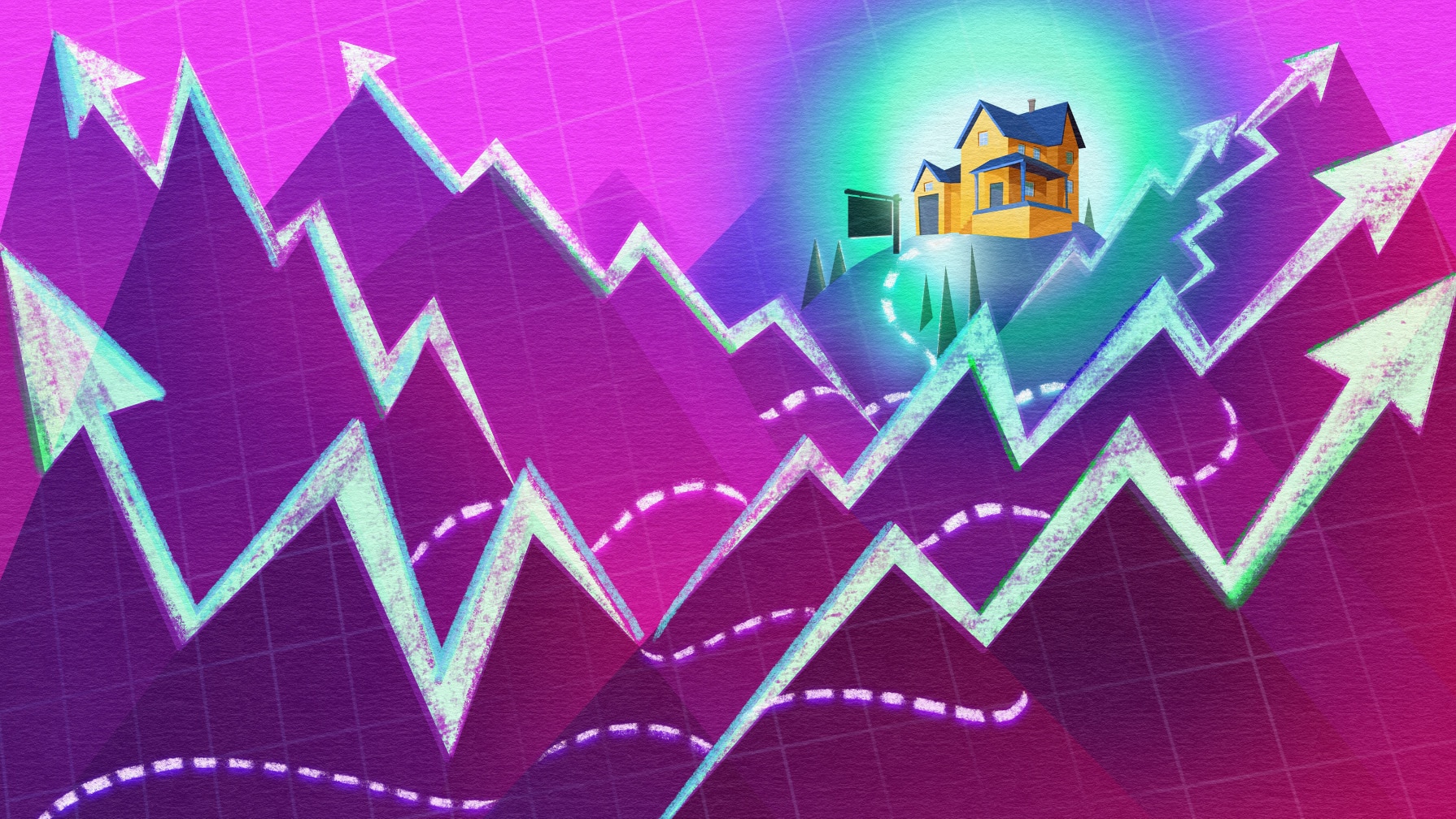Sometimes it feels like our parents’ generation had all the fun. Before climate change became a full-blown crisis and a global pandemic hit, buying a house was more like buying a car than winning the lottery. Sure, Mom and Dad still had to save up for their down payment, but when homes were selling for $80,000, setting aside that elusive 20% took five years, not 15.
In June, the average Canadian home sold for $665,850. While house sales (and prices) have declined since the market peaked in February, that number is still over 10 times our country’s median after-tax income, which is $62,900. Affordability is further hampered by the acute interest rate rise we’ve experienced this year: It’s now more expensive to borrow money than it was earlier this year. While deemed necessary by the Bank of Canada to help cool inflation, it hasn’t done much to help prospective first time home buyers, who now face both high house prices and higher mortgage rates.
If you’re a prospective home buyer, you may be feeling discouraged. You’re not alone. According to a recent Ipsos poll, two in three Canadians are worried they won’t be able to afford a home. Earlier this year, I too was regretting my generational bad luck wondering if perhaps it was just too late. Turns out, it wasn’t. And it doesn’t have to be for you either. As a newly minted homeowner, I’m here to share some of the key lessons I learned throughout the process.
The money stuff
If you’ve never purchased property before, the process can be somewhat intimidating. To ensure you don’t assume debt you can’t afford, it’s important to take a close look at your finances before going any further. Sort through your savings and investments and make note of any financial liabilities.
Know your budget
Next, it’s time to find out what you can afford. Many financial institutions offer mortgage affordability advice. After you’ve handed over all the requisite documentation, income, existing debt and down payment, you’ll be provided with an estimate of what you can afford. If you’re extra cautious like me, it can help to run your own numbers. By using a simple online mortgage calculator, I got an estimate of monthly payments, and what they might become as interest rates rise. It can be easier to budget more effectively if you estimate what your monthly mortgage payments could look like both now and in the future, along with the other costs of running a home.

Gather your down payment
To buy a home in Canada, you must provide a down payment of at least 5% of the first $500,000. If the sale price is between $500,000 and $999,000, you’ll need to provide 5% of the first $500,000 and 10% for the portion above. And if the sale price is over $1 million, a 20% down payment is required. It’s also important to note that buyers are required to purchase mortgage loan insurance for any purchase in which the down payment is less than 20%.
The funds for your down payment can come from a variety of sources, but the most common include personal savings, investments, and gifts (such as money from the bank of mom and dad): According to a recent study, first-timers are predominantly relying on personal savings and gifts. One option first-time buyers can use is the federal Home Buyers’ Plan which allows eligible buyers to withdraw up to $35,000 tax-free from their Registered Retirement Saving Plan (RRSP). If you choose to withdraw from your RRSP, you will be required to repay the amount within 15 years. In their most recent budget, the federal government announced a new First Home Savings Account which will be available starting in 2023. This plan allows prospective first-time home buyers to save for a home using a tax free account.
Get pre-approved
Before you hit up an open house, it’s important to obtain a mortgage pre-approval. A pre-approval from a financial institution allows you to better understand your affordability when shopping for a home. A pre-approval also provides an interest rate hold for a set period of time. Keep in mind that a variable rate is tied to the lender’s prime rate and fluctuates. If you have questions about the difference between fixed and variable mortgage rates, it can help to speak with a lending specialist from a financial institution.
Here’s something I wish I had known earlier: If you plan to use your interest rate hold, you must actually close on a property before that set period is up. Assuming you have a 120-day rate hold and a standard 60-day close, you’ll need to have an offer accepted within 60 days of your pre-approval to retain the agreed interest rate. A rate hold can be particularly helpful when interest rate increases are occurring rapidly, as they are in 2022.
The Hunt
Know what you need
There are so many different types of properties out there — it can be overwhelming. For first time home-buyers, it’s helpful if you have a solid understanding of what you need versus what you want. You may want a two-story home with a large yard and original hardwood flooring, but what you may actually need is a house in a good neighbourhood, with two bedrooms and a roof that doesn’t leak.
Keep your emotions out of it
No matter what happens on an offer: know your budget, stick to what you can afford and keep your emotions out of it. It’s so easy to keep adding to your offer when the house you want feels within your grasp. You may lose on more than one property you bid on before an offer is accepted. Each time, it may feel like you’re losing out on the last good one out there. Spoiler: There will always be another house. You don’t want to end up spending more than you can afford just because you got carried away during an intense bidding war.
Don’t get hung up on the cosmetics
Every day, new houses are put up for sale. While buyers may not be flocking as they were a few months ago, the market can still be competitive. You may be able to gain an advantage at your price point by going a little against the grain. For one, try not to get hung up on cosmetics. Don’t throw a whole house in the rejection bin just because it’s not your dream house. Keeping an open mind can help you identify opportunities. For me, this meant ignoring the tacky window dressings and outdated kitchen cabinets and focusing on the flow of the floor plan and natural lighting.
Here’s another thing I wish I had known earlier: Turnkey homes (upgraded and ready for moving in) have often been recently renovated to sell. By offering on a turnkey home (unless you absolutely need one), you may be paying a premium for someone else’s design choices. You may be able to save money by considering a home that hasn’t been recently renovated but has potential.
Look at older listings
Generally, a house is listed for roughly seven days before the listing agent holds an offer night. If you find a house you like that has been listed longer than that, do a little digging, you may discover there’s nothing wrong with the house — it’s simply been forgotten by potential buyers. This is particularly true now, given how house sales have declined recently. An older listing doesn’t necessarily mean a bad one and you may also have an opportunity to negotiate on the price.
Closing: The count-down
Congratulations! Your offer has been accepted and you’re under contract for your first home. You can officially begin the count-down to move-in day.
Remember your closing costs
Did you think you were done spending money? You’re not. In addition to your accepted offer, there are a host of other fees associated with closing on a house that you’ll need to pay before you get your keys. These fees include: Land Transfer Tax, lawyer’s fees, title insurance, an appraisal fee, property taxes and utility setup fees to name a few. Understanding these expenses before you make an offer can help keep you on the safe side of your price ceiling.
Keep a checklist
Keep a comprehensive checklist of everything you need to do as you close on your new home. Everything from signing the mortgage documents to sending secure photographic proof of deposit to your realtor. You may also want to set a reminder for next year’s tax season: As a first-time home buyer, you could be eligible to claim up to $5,000 of the purchase price, providing you with potential tax savings in the year to come. Visit the Canada Revenue Agency’s website for more details.
Buying a home is a huge undertaking, but if you take it step by step, do your research and ask a lot of questions, it can even be fun. For more information, speak with a lending specialist from a financial institution.





